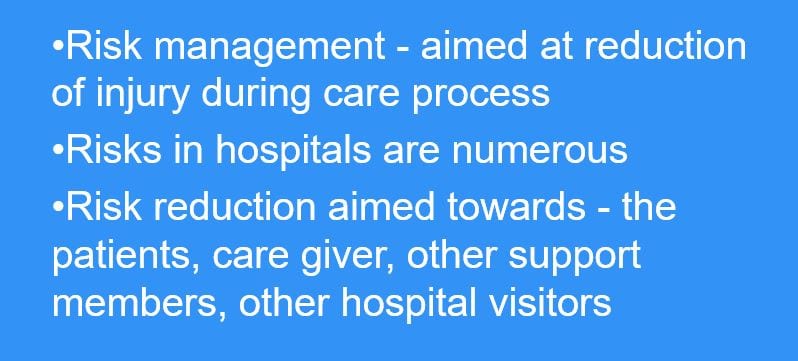Discussion of Educational Program on Risk Management
Discussion of Educational Program on Risk Management
Discussion of Educational Program on Risk Management
Educational Program on Risk Management Part Two – Slide Presentation:
The purpose of this assignment is to create an educational risk management presentation.
Building upon the outline for an educational session you created in the Educational Program on Risk Management Part One: Outline of Topic 2 assignment, develop a 12-15 slide PowerPoint presentation that expands in greater detail on how and why your organization should implement your proposed risk management strategy. Incorporate any instructor feedback from the Topic 2 assignment into this presentation and include talking points in the speaker notes section of each slide.
Keep in mind that the PowerPoint is meant to serve as a visual aide to bolster your presentation and is intended to highlight main ideas and key points. Do not use dense blocks of text or more than 7 bullet points of text per slide. However, you may include supplementary images, graphs, and data where relevant.
To successfully complete this assignment, include the following sections as per your outline from Topic 2, though you may include any additional sections as needed:
1. Introduction
2. Rationale
3. Support
4. Implementation
5. Challenges
6. Evaluation
7. Opportunities
You are required to support your statements with a minimum of six citations from appropriate credible sources.
Refer to the resource, “Creating Effective PowerPoint Presentations,” located in the Student Success Center, for additional guidance on completing this assignment in the appropriate style.
While APA style is not required for the body of this assignment, solid academic writing is expected, and documentation of sources should be presented using APA formatting guidelines, which can be found in the APA Style Guide, located in the Student Success Center.
This assignment uses a rubric. Please review the rubric prior to beginning the assignment to become familiar with the expectations for successful completion.
You are not required to submit this assignment to LopesWrite.PART ONE BELOW:
A Falls Risk Management Plan at Twin Valley Health Care Hospital in Columbus, Ohio.
Idriss Mansaray
HLT 308V-O500 Risk Management and Health Care Regulations
Grand Canyon University
July 12, 2020
Introduction
Risk management in health care refers to an activity aimed at reduction of cases of injury in the process of treatment and recovery process of patients. Risks in hospitals are numerous but with good management strategies a lot can be achieved with a goal of promoting safe, good and affordable health care in the country. The risk reduction can be aimed towards the patients, health care providers, support care staff or visitors of patients.
Rationale
Introduction of safety beds in hospitals should be taken to reduce chances of patient falls. Patient falls in hospitals over the years has been a major concern in the welfare of hospitals (Heng, et al, 2020). Falls in hospitals can be fatal and affect the patient’s recovery process. Injuries associated with hospital falls have been on the rise in the past few years with people arguing that negligence is the main cause of the problem. 1 out of every 50 patients in our hospitals fall every year from the hospitals according to data. Safety beds in hospitals will be a major step towards the reduction of patient falls.
The Need for Fall Risk Management Plan
According to the data on health care falls in the country one out of fifty patients fall from their hospital beds. The falls are associated with lack of proper supervision in the wards (Lopez, Karen Dunn, et al, 2010). It is a case that should be solved with proper partnership between health care workers and government. Safety beds are a way to ensure safety in hospitals and has proven to be a dependable solution. A partnership with bed manufacturers should solve the issue.
Steps to Implement a Fall risk Plan
The steps in adoption of safety beds starts with health care workers recognizing the falls and the devastating effects it causes (Sand-Jecklin). The next step is bringing in the stakeholders involved in the realization of safety in hospitals. Medical staff and support staff should be educated on the need to have safe beds that ensure patients recover without added injuries. The next step is to bring bed manufacturers on board. This will help incorporate all the structural suggestions into the making of the beds. The making of the bed will need a test of the effectiveness of the designs.
A good bed designed for patient safety must have an emergency call box, side rails and strong materials that are resistant to rust (Lake, Eileen T., et al., 2010). A good bed should also accommodate provision of adjustment depending on the preference of the practitioners. The test is important as it will ensure the beds are up to the standards needed. The next step is implementation of the project.
Obstacles in Executing Falls Risk Plan
The project however will experience various challenges in the implementation. Resistance from the health care owners may privately see it as a challenge as revenues will go into expenses of making new beds (Campione, 2018). The health care workers will need time to adjust to the new regulations by the governments. Learning of new safety measures will pose a challenge to the health care workers and support staff. Another problem in the process is the speed of adoption. The changes will need to be sudden but will have many benefits for the sector.
Evaluation of the Falls Risk Plan
Introduction of beds that are safer for the patients is aimed at the realizing of safer health care and affordable services in the country (Sexton, J. Bryan, et al, 2018). It is for this reason that it is important for the health sector take into account the change for success.
Conclusion and Recommendations for Improvement
Another important aspect that the health care sector should adopt is the use of technology in monitoring and evaluating the safety of patients in hospitals. Use of smart assistance in medical sector should adversely reduce the chances of erratic patients hurting others. The safety can be monitored by sensors fitted to the beds that monitor and report any movement that does not look normal. A smart way aspect in health care will improve the chances of good and safe health care systems in the country. Health care providers will also appreciate the ease of the process while providing top notch treatment.
References
Campione, Joanne, and Theresa Famolaro. “Promising practices for improving hospital patient safety culture.” The Joint Commission Journal on Quality and Patient Safety 44.1 (2018): 23-32.
Cournan, Michele, Benjamin Fusco?Gessick, and Laura Wright. “Improving patient safety through video monitoring.” Rehabilitation Nursing (2016).
Lake, Eileen T., et al. “Patient falls: Association with hospital Magnet status and nursing unit staffing.” Research in nursing & health 33.5 (2010): 413-425.
Lopez, Karen Dunn, et al. “Cognitive work analysis to evaluate the problem of patient falls in an inpatient setting.” Journal of the American Medical Informatics Association 17.3 (2010): 313-321.
Sand-Jecklin, Kari, Jennifer Ray Johnson, and Sharon Tylka. “Protecting patient safety: can video monitoring prevent falls in high-risk patient populations?.” Journal of nursing care quality 31.2 (2016): 131-138.
Sexton, J. Bryan, et al. “Providing feedback following Leadership WalkRounds is associated with better patient safety culture, higher employee engagement and lower burnout.” BMJ quality & safety 27.4 (2018): 261-270.
Answer preview to Educational Program on Risk Management Part Two – Slide Presentation Discussion of Educational Program on Risk Management Discussion of Educational Program on Risk Management

17 slides
Use the following coupon code :
NursesHomework

